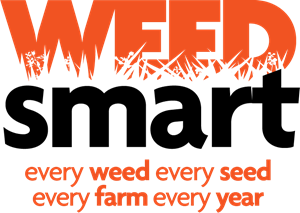
Weeds costs growers big dollars each year. Whether it be through herbicide use, other weed management tools, or lost yield and quality at harvest. This applies to many broadacre, intensive cropping and pasture situations. Undoubtedly weeds will continue to play a massive part in our farming systems, and there is a cost of complacency when it comes to dealing with them.
Increasing herbicide resistance issues has meant that we’ve needed to ‘think outside of the box’ and adapt our farming practices to keep weed numbers at bay. In the last few decades we’ve seen a wave of weed science research, new herbicide MOA’s (mode of actions), and now new technologies available to combat problem weeds. Keeping on top of this information has been made easier than ever through the industry representation body, WeedSmart.
As well as working directly with clients, part of my role is as an extension agronomist for the WeedSmart program. This involves communicating weeds focused messages across SA, Victoria and Tasmania, in high rainfall regions. The overarching extension message focuses on preventing herbicide resistance, and dealing with common weeds in cropping and pasture situations.
“If you’re on a good thing, don’t stick to it” is a common mantra being echoed by the WeedSmart team. It couldn’t be more true when it comes to management of weeds in the long term. Any tool that provides diversity in control will prevent adaptation. Weed adaptation is the major reason we’re still facing weed issues despite all the modern tools we now have available.
To communicate these practical messages, WeedSmart have developed six overarching principles, coined as the 'the big 6'. Consider how these may, or may not be currently adopted on your property:
1. Rotate crops and pastures
Implement break crops, double breaks, pasture phases, and aim for consecutive years of no seed set on problem paddocks. This will allow a range of different tools and herbicide MOA’s to be utilized. Start by developing 3-5 year rotation plans, ranking paddocks in term of weed pressure, and having a proactive approach rather than dealing with weed blowouts.
2. Double knock to preserve glyphosate
Following up the glyphosate application with a second mode of action (paraquat) to kill any surviving weeds. Glyphosate resistance is only increasing in our farming systems, our only hope is to be extremely diligent in making sure no glyphosate survivors slip through the cracks.
3. Mix and rotate herbicides
Whilst somewhat self-explanatory, this principle often sounds easier in theory than what is practically adopted. The main principle behind this is: rotating buys you time, mixing buys you shots. Rotating between common herbicide MOA over a number of years still can lead to resistance over time. But mixing two or more herbicides together (think pre-emergent, broadleaf and grass herbicides) will allow the weeds to be controlled by more than one MOA. There will be a much lower chance of selecting for resistance weeds to one MOA, and essential buying you more ‘shots’ or opportunities to use those herbicides.
4. Stop weed seed set
Think: crop topping canola and pulse crops, windrowing canola, hay, silage, brown-manuring dirty paddocks, and spray-topping pasture paddocks. This aims to firstly reduce the size of the weed seed bank heading into next season and, is an opportunity to prevent any resistance escapee weeds from setting seed.
5. Increase crop competition
Crop types and varieties differ in vigour and how successfully they can out compete weeds. Choosing vigorous and competitive rotation options is one of the most underrated non-herbicide tools for weed control. Take the time to consider what other factors might be a weak link for poor crop vigour/ competition. Think of soil health, nutrition, drainage, row spacing, row orientation, time of sowing, and other underlying soil constraints such as pH, sodicity and compaction.
6. Harvest weed seed control (HWSC)
The last chance to clean up weed seeds is at, or after harvest. Big developments in this space has made it easier to ‘bolt-on’ a seed mill to harvesters and destroy weed seeds in one pass. This has superseded the other lower cost, but still effective HWSC options: chaff-lining, chaff-decking, narrow windrow burn, chaff cart and baling. Any tool that takes out a reasonable % of weed seeds at harvest is worthwhile looking into.
By stacking as many of the weed management ‘Big 6’ tools as possible, you’ll be heading in the right direction. Finding the balance between diversity of rotations vs simplicity of operations; and profitable vs sustainable strategies is a continual challenge we work through with clients. Take a look at your farming system from a strategic, long-term perspective, and consider how these strategies can be implemented to combat weeds each season.
Follow up by:
- Tuning in to the WeedSmart Podcast
- Checking out the website, and signing up to the monthly whip around
- Follow WeedSmart on Twitter and Facebook